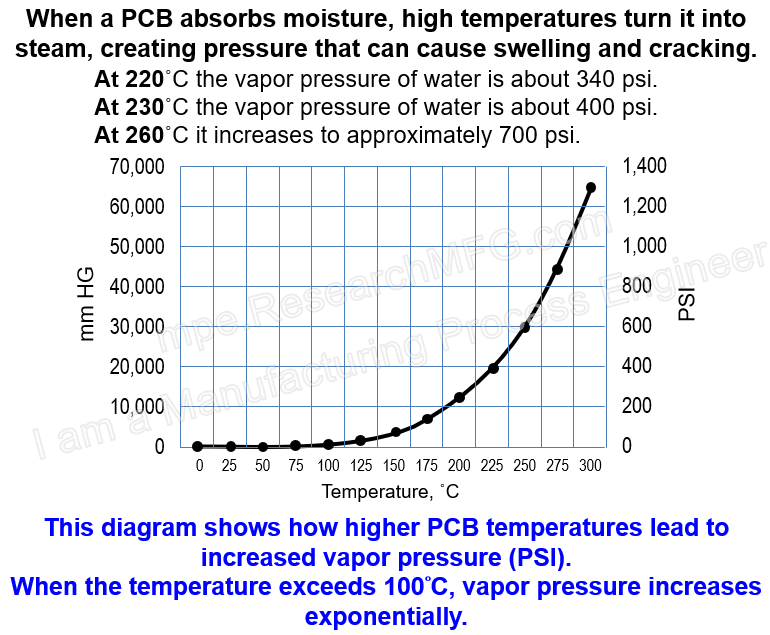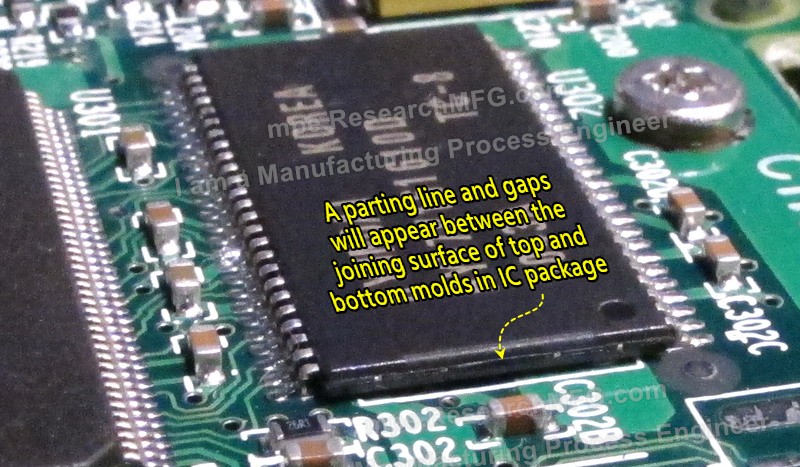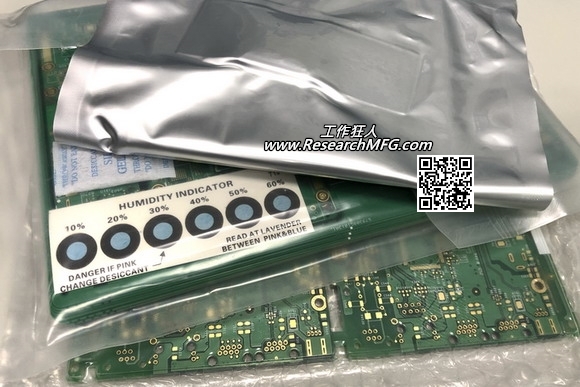
The main reasons for PCB delamination or “popcorning” are primarily (1) moisture absorption and (2) excessive α2/Z-axis CTE (Coefficient of Thermal Expansion). Among these, moisture absorption is responsible for about 70% of delamination issues. Other factors, such as uneven thermal expansion, inconsistent cooling and heating, mechanical damage during processing, or poor oxidation treatment, can also contribute—but their impact is generally much lower.
Why Is Moisture the Main Cause of PCB Delamination?
Moisture doesn’t have a significant effect on PCB popcorning (also known as the popcorn effect) when the temperature is below 100°C. However, once the temperature exceeds 100°C, moisture (H₂O) starts acting as a plasticizer for the resin.
A plasticizer is an additive that increases the flexibility of a material or makes it more fluid. When moisture molecules are absorbed into the PCB material, they weaken the molecular structure—similar to how paper becomes soft when wet. As the absorbed water heats up and turns into steam, it expands, further pushing apart the molecular structure. This weakens the bonding forces within the PCB, making it more susceptible to cracking.
If the PCB absorbs too much moisture, its Tg (Glass Transition Temperature) decreases (ΔTg should ideally be less than 5°C). This means the resin transitions into its rubbery state earlier than expected, causing rapid Z-axis swelling and leading to sudden cracking—especially within the 100°C to Tg range.
Looking at the reference pressure chart, the vapor pressure of water increases exponentially once it exceeds 100°C, significantly stressing the PCB structure.
The Role of CTE and Internal Moisture
The X and Y CTE values of PCB materials are relatively stable, typically around 15–16 ppm/°C. However, internal moisture hidden within the PCB can also act as a plasticizer, working alongside external moisture to accelerate the degradation of the material.
Once the resin temperature exceeds Tg, it enters a rubbery state. At this point, moisture is no longer the primary factor behind delamination, as most of the water has already evaporated. Additionally, the rubbery resin is more flexible, making it less prone to sudden cracking.
Where Does the Moisture in PCBs Come From?
Since moisture is a major cause of PCB delamination, it’s important to understand where it comes from. Most people assume that moisture mainly comes from external sources—absorbed during manufacturing or gradually diffused from the environment while in storage. However, there are several less obvious sources of moisture inside the PCB itself:
- The resin molecules contain hydroxyl (-OH) groups – Due to their polar nature, water molecules can be present in the resin, especially if the chemical composition includes hydroxyl groups (OH), which have the potential to retain moisture.
- Moisture trapped at the resin and fiberglass interface – PCB materials are typically made by weaving resin and fiberglass together. If the weave is not dense enough, gaps can form, allowing moisture to accumulate. Using low-permeability flat glass fibers can help reduce moisture retention.
- Moisture trapped between the resin and copper foil layers – The interface between the resin and copper layers can also hold moisture.
- Moisture inside voids within the PCB material – Any tiny voids or air pockets in the PCB structure can act as moisture traps.
How to Prevent Moisture-Related PCB Delamination – Baking
Since moisture is the main cause of PCB popcorning, removing moisture from the PCB before processing can greatly reduce delamination issues. The best way to do this is through baking.
To effectively remove moisture, the baking process should follow these key guidelines:
- Bake at a temperature slightly above 100°C – A recommended temperature is 105°C to ensure moisture turns into vapor and can escape easily. (This also accounts for potential temperature variations in the oven.)
- Separate each PCB during baking – Avoid stacking the PCBs, as overlapping can trap moisture and make it harder to evaporate.
- Use an oven with a proper ventilation system – Without ventilation, the oven will fill with steam, preventing effective moisture removal.
Recommended Reading:
Controlling Moisture Absorption from PCB Material Selection and Manufacturing
While baking is an effective way to reduce PCB delamination, it is time-consuming, labor-intensive, and costly. Additionally, baking can lower the Tg (glass transition temperature) of the PCB, which may introduce other issues. A better approach is to control moisture absorption from the very beginning—through careful PCB material selection and process control.
Key Ways to Reduce Moisture Absorption in PCBs
-
Choose Resin Materials That Resist Moisture Absorption
If the PCB material has high polarity, it will absorb more moisture. Selecting resins with low moisture absorption helps prevent moisture-related defects.
- Use Flattened (Open) Fiberglass Weave

- Reducing gaps between resin and fiberglass layers helps prevent moisture from accumulating.
- The tightness of the fiberglass weave is critical—loose weaves create gaps where moisture can collect.
- A low-permeability flat weave is recommended, as it reduces moisture retention and minimizes signal integrity issues in high-frequency PCBs.
-
Optimize Lamination Process Control
After lamination and post-baking, multilayer PCBs should be tested for Tg stability:
- Measure Tg twice (before and after lamination) using the same method and equipment.
- If the ΔTg (Tg2 – Tg1) exceeds 2–3°C, it means the curing process (polymerization & cross-linking) was incomplete.
- Under-cured boards are more prone to moisture absorption and delamination.
-
Test Tg Using TM-650 Standard (TMA Method)
- Measure the Tg of suspect PCB material using IPC-TM-650, Section 2.4.24.1 (TMA Method).
- Compare the measured Tg with the supplier’s specified value:
- If the actual Tg is 5°C lower than the spec, the material already has a moisture issue.
- Moisture in the resin acts as a plasticizer, lowering Tg and accelerating the transition to a rubbery state.
-
Pre-Baking for PCBs Stored Over Three Months
- Aged multilayer PCBs can experience:
- Internal stress buildup (from lamination).
- Increased moisture absorption, leading to Z-axis expansion.
-
To prevent delamination, use one of these pre-baking methods before reflow soldering:
- Standard Pre-Bake: 105°C for 24 hours.
- High-Pressure Flattening Method: Stack 50 smartphone PCBs together and bake at 185°C, 70 PSI, in a nitrogen environment for 2 hours.
-
Baking is necessary for aged PCBs, but it increases costs and can negatively affect OSP (Organic Solderability Preservative) coatings.
-
Always bake PCBs individually to allow moisture to escape completely.
- Aged multilayer PCBs can experience:
Final Thoughts from Workingbear
These insights are based on my experiences and discussions in PCB manufacturing. Feel free to share your thoughts or ask questions in the comments!








Leave a Reply